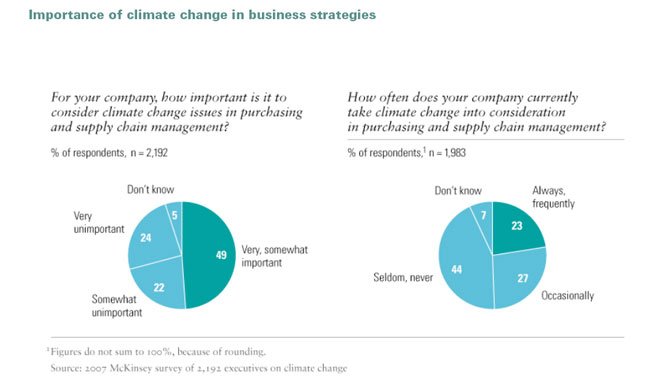Intention Ahead of Action on Green, McKinsey Survey Finds

Source: McKinsey
Relatively few companies as yet actually set emission targets. More than 60% of executives whose companies consider managing environmental issues to be at least somewhat important report at the same time that their companies haven’t defined corporate emission targets for greenhouse gases; another 15 percent don’t know if their companies have or not.
Upstream Supply Chain is Often the Real Driver of Emissions
But the real challenge may be the fact that a preponderance of the carbon emissions from the supply chain of many companies comes from their upstream supply partners, whose operations of course they do not directly control.
McKinsey says its analysis shows that for consumer goods makers, high-tech players, and other manufacturers, 40-60% of carbon footprint resides upstream in the supply chain—from raw materials, transport, and packaging to the energy consumed in manufacturing processes. For retailers, the figure can be 80% or more.
This means any significant carbon-abatement activities will require collaboration with supply chain partners – a time consuming and potentially expensive process.
First, a company needs to understand in detail the emissions associated with purchased products or materials, and then to analyze abatement opportunities systematically, including reduction opportunities and any potential costs.
McKinsey, however, believes that the cost impact will often be negligible.
“We find that many of the opportunities to reduce emissions carry no net life-cycle costs—the upfront investment more than pays for itself through lower energy or material usage,” McKinsey’s Chris Brickman and Drew Ungerman say. “Others, however, will require tradeoffs between emissions and profitability, in areas such as logistics and product design (including product specification and functionality).”
They say forward-looking companies are using such discussions as opportunities for supplier development, for example by transferring best practices in manufacturing, purchasing, and R&D—as well as energy efficiency—to key suppliers.
“This opens the possibility of still lower costs and improved operational performance, in addition to helping suppliers remove more carbon from their supply chains,” they say.
Do the McKinsey surveys results surprise you at all? Do you expect action to follow the rhetoric soon, or will we stay in this state for a long time? What will be the key to working with suppliers to reduce emissions – or should that even be a company’s concern? Let us know your thoughts at the Feedback button below.